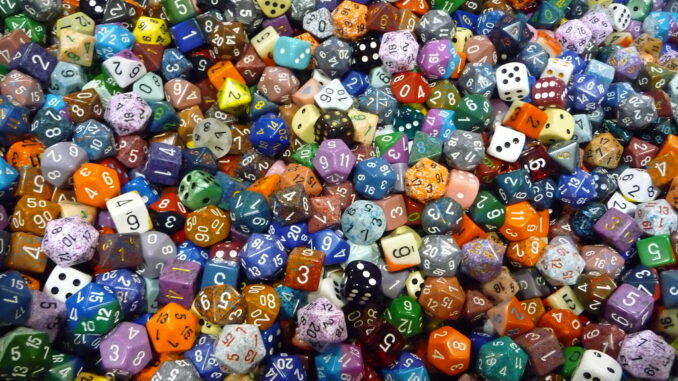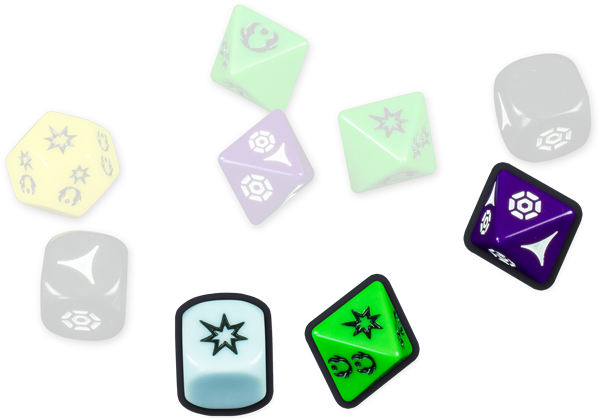
Ah, dice pools. Nothing feels better than throwing a handful of different dice onto the table and seeing how you roll. But I’m getting ahead of myself. In its most basic form, a dice pool is just a collection of two or more dice that a player rolls together, usually for task resolution. Often, a dice pool is assembled by gathering a number of dice indicated by different game stats, such as attributes and skills. The dice could all be the same, or each die in the pool could be of a different type. While each game may vary slightly in how they employ dice pools, in general, there are two main forms of dice pool resolution: summing and counting successes.
 The oldest dice pool method is summing. With summing, a player assembles a number of dice according to the game’s rules, rolls them, and adds up the numbers/pips that appear on each die. The total is then compared to a target number, and if the total is greater than (and in some cases, equal to) the target number, the roll is considered successful. A well-known game that uses this method is West End Game’s Star Wars Roleplaying Game. In that example, the dice are assembled according to the die ratings of relevant attributes and skills and then rolled against a target number to see if the check is successful.
The oldest dice pool method is summing. With summing, a player assembles a number of dice according to the game’s rules, rolls them, and adds up the numbers/pips that appear on each die. The total is then compared to a target number, and if the total is greater than (and in some cases, equal to) the target number, the roll is considered successful. A well-known game that uses this method is West End Game’s Star Wars Roleplaying Game. In that example, the dice are assembled according to the die ratings of relevant attributes and skills and then rolled against a target number to see if the check is successful.
The other method of dice pool resolution is counting successes. In this method, a player assembles the dice pool according to the game’s rules, as in summing, except instead of adding up the numbers/pips on the dice, the player looks at the result of each die and determines if the dice meets the conditions of success. In most cases, if a player rolls at least one success, they succeed.
The conditions of success can vary from game to game. One example of counting successes can be seen in the Ubiquity system that underlies games like Hollow Earth Expedition and Leagues of Adventure. In the Ubiquity system, a player rolls a number of dice equal to the relevant stats. Every die that rolls even counts as a success and every die that rolls odd is ignored. If the number of successes is greater than or equal to the difficulty number assigned to a task, the action succeeds. Otherwise, it fails. Another interesting idiosyncrasy of the system is that if the difficulty number is equal to or lower than your dice pool’s average (generally the number of dice divided by 2), you can automatically succeed without rolling.
 Another example of counting successes comes from the Narrative Dice System used by the most recent Star Wars RPG and the Genesys RPG. In that system, the dice pool is assembled with positive dice according to the ratings of a relevant attribute and skill, and are rolled against one or more negative dice. If at least one success symbols remain from the positive dice after canceling out, the check succeeds. Otherwise, it fails.
Another example of counting successes comes from the Narrative Dice System used by the most recent Star Wars RPG and the Genesys RPG. In that system, the dice pool is assembled with positive dice according to the ratings of a relevant attribute and skill, and are rolled against one or more negative dice. If at least one success symbols remain from the positive dice after canceling out, the check succeeds. Otherwise, it fails.
As mentioned above, it can be a lot of fun rolling a bunch of dice in a dice pool. However, it can be a bit unwieldy when using the summing method of resolution with a large number of dice. Thankfully, modern game design sensibilities generally avoid calling for large numbers of dice when summing or use the counting successes method to make determining success easier.
What do you think about dice pools? Do you have a favorite game that uses dice pools? Is there a method of dice pool resolution I forgot to mention? Let me know in the comments!
Do you have thoughts or questions about the article or suggestions for future content? Leave a comment below or drop me a line at jtdimino@d20radio.com.
